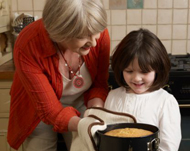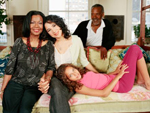There is the public image and the private image. This dichotomy often creates great confusion and distress and can lead the child to questioning of reality and their identity. What is meant by the public image is what the leader(s) of the family structure which to convey to the outside world, whereas the private image is that dysfunction which lies within that these individuals are wanting to conceal at whatever cost. Familial secrets exist, trust is lacking, and children are guarded about their expression. Children may be lied to and dilemmas between family members masked or suppressed. The real nature of things may be shrouded in confusion and 'mystery'. Mixed messages may arise, or the members of the family may see themselves placed in 'damned if you do and damned if you don't situations." Some family members may frustrate themselves in striving for the 'ideal' structure which never arrives.
 In the dysfunctional structure, as in oppressive societal regimes, there are those who seek rebellion. Rebellion against the structure becomes more pronounced in the stage of adolescence where already the teenager is beginning to exert a greater sense of autonomy and desire to be apart from the familial structure. However, because children lack the resources for which to engage in a rebellion that could be successful, the rebellion is always squashed. What does this leave the child to do? They can do little but endure and await the period where they can break free from the structure that they find oppressive. What is termed 'conduct' problems is usually this desire to break free from what the child has perceived as oppressive in their lives. Often without the appropriate guidance and 'moral compass' coming from the familial structure, their rebellion turns not just to fighting the familial structure, but the structures outside which also resemble the authority they have found oppressive. This type of rebellion is usually futile and self-destructive. There exists the warring between parents themselves, which cause the children to be placed in the predicament of divided loyalties, not knowing which parent to turn towards. There may exist the opposing styles, one parent who is permissive and one who is the authoritarian. This scenario leads to immense conflict.
In the dysfunctional structure, as in oppressive societal regimes, there are those who seek rebellion. Rebellion against the structure becomes more pronounced in the stage of adolescence where already the teenager is beginning to exert a greater sense of autonomy and desire to be apart from the familial structure. However, because children lack the resources for which to engage in a rebellion that could be successful, the rebellion is always squashed. What does this leave the child to do? They can do little but endure and await the period where they can break free from the structure that they find oppressive. What is termed 'conduct' problems is usually this desire to break free from what the child has perceived as oppressive in their lives. Often without the appropriate guidance and 'moral compass' coming from the familial structure, their rebellion turns not just to fighting the familial structure, but the structures outside which also resemble the authority they have found oppressive. This type of rebellion is usually futile and self-destructive. There exists the warring between parents themselves, which cause the children to be placed in the predicament of divided loyalties, not knowing which parent to turn towards. There may exist the opposing styles, one parent who is permissive and one who is the authoritarian. This scenario leads to immense conflict.
 In the worst scenarios, the combination of 'seared in' memories of trauma, with the dynamics as mentioned above leads to the disintegration of the person. Reality is too painful, and is questionable. Reality is not reliable. As a result, this member of the family seeks to 'break out' and develops the behaviour that would be termed psychosis. They retreat into their own inner world, their own sense of reality and identity. This too is often a painful journey, but not anymore painful than the experience of the structure they have felt subjected to. Children in some structures are still viewed as ‘property’; therefore they are often enslaved to the faulty structures. Mere compliance does not earn one's freedom but neither does active rebellion. Cycles exist, once a structure is learned, it is bound for continuation. The child in many instances will perpetuate the structure that they learned once they have their own family to lead. The stresses and trauma of one can often become the stresses and trauma of all, it becomes a collective trauma. The faulty structures within the family dynamics are seen in society as a whole. Therefore, we are all shaped by the society and the family structures in which we have encountered. Thus, concepts of 'mental illness' or the 'unruly child' all take shape and form by the experience one has in the family and ultimately in society. These are not biological processes, but rather social and political processes.
In the worst scenarios, the combination of 'seared in' memories of trauma, with the dynamics as mentioned above leads to the disintegration of the person. Reality is too painful, and is questionable. Reality is not reliable. As a result, this member of the family seeks to 'break out' and develops the behaviour that would be termed psychosis. They retreat into their own inner world, their own sense of reality and identity. This too is often a painful journey, but not anymore painful than the experience of the structure they have felt subjected to. Children in some structures are still viewed as ‘property’; therefore they are often enslaved to the faulty structures. Mere compliance does not earn one's freedom but neither does active rebellion. Cycles exist, once a structure is learned, it is bound for continuation. The child in many instances will perpetuate the structure that they learned once they have their own family to lead. The stresses and trauma of one can often become the stresses and trauma of all, it becomes a collective trauma. The faulty structures within the family dynamics are seen in society as a whole. Therefore, we are all shaped by the society and the family structures in which we have encountered. Thus, concepts of 'mental illness' or the 'unruly child' all take shape and form by the experience one has in the family and ultimately in society. These are not biological processes, but rather social and political processes.
If the structure of family can instead become collective in its ideas of shared energy for problem solving, the allowance for independent thought and action, and the conception of freedom with responsibility, it may survive.









Join the Discussion
Type out your comment here:
You must be logged in to post a comment.